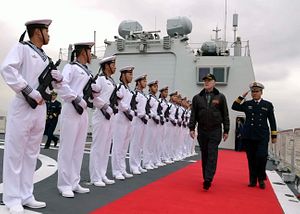On Friday, the United States Department of Defense released its annual report to Congress on “Military and Security Developments Involving the People’s Republic of China.” The 156-page document provides a helpful summary of the trends the U.S. military has observed in China and expands on observations made last year (see my discussion of last year’s report here). The document is primarily observational and includes few predictions and recommendations. Below, I’ve included a few of my takeaways after perusing the report.
This year, the document devotes considerable attention to China’s historic reorganization of the People’s Liberation Army (PLA). Beginning late last year, the Chinese military has undergone major organizational changes. Accordingly, the report highlights the PLA’s shift from its seven legacy military regions to five “theaters of operations,” the creation of a PLA Army service (yes, that’s the People’s Liberation Army Army), and the re-designation of the PLA Second Artillery as the PLA Rocket Force (PLARF). The report also draws attention to China’s 2015 defense white paper, which outlined a greater role for the PLA Navy in the maritime domain than previous iterations.
Like the 2015 report, this year’s report draws attention to the South China Sea and includes satellite imagery and helpful maps of the seven Spratly features that China has developed into artificial islands. The report notes China’s so-called ‘salami-slicing’ approach to maritime territorial disputes, arguing that “China is using coercive tactics…to advance their interests in ways that are calculated to fall below the threshold of provoking conflict.” The Pentagon also notes that “China demonstrated a willingness to tolerate higher levels of tension in the pursuit of its interests … especially in the East and South China Sea[s].” Regarding the South China Sea, the report further notes that all of China’s airfields there (Woody Island, in addition to the three Spratly airstrips) can “support any aircraft in China’s inventory.”
Regarding the PLAN’s modernization, the report draws particular attention to the PLAN’s submarine force, highlighting China’s expanding sub-surface fleet. The Pentagon has a particularly interesting prediction in the report; namely, it expects China to conduct its first “SSBN (ballistic missile nuclear submarine) nuclear deterrence patrol sometime in 2016.” The Pentagon notes continuing shortcomings for the Chinese Navy in anti-submarine warfare capabilities. (Curiously, the report omits any mention of the Gaoxin-6, the PLAN’s capable homebrewed version of the Lockheed Martin P-3C Orion).
In South Asia and the Indian Ocean region (IOR), the 2016 report offer some interesting observations. Last year, the Pentagon for the first time confirmed that Chinese Shang- and Song-class submarines were carrying out operations in the IOR. This year’s report offers some important updates. It acknowledges continued submarine activities and increased Chinese familiarity with subsurface navigation in the IOR. Additionally, while it notes that “China’s current naval logistics footprint in the Indian Ocean is unable to support major combat operations in South Asia,” the Pentagon acknowledges the upcoming naval base at Djibouti.
This year’s report includes a detail breakdown of China’s ballistic and cruise missiles. Scott LaFoy helpfully graphed the Pentagon’s 2015 and 2016 numbers in the same chart, demonstrating that U.S. estimates of China’s inter-continental ballistic missiles–including the DF-4, DF-5, DF-5A, DF-5B, DF-31, DF-31A, and DF-41, have increased year-on-year, where they’d stayed fairly constant since 2010. The report notes China’s continuing progress toward a true nuclear triad; it acknowledges China’s development of long-range bombers “capable of performing strategic deterrence,” including a stealth strategic bomber. (As a fascinating aside, the Pentagon notes that “India’s nuclear force is an additional driver behind China’s nuclear force.”)
There’s a lot more in the report that I haven’t discussed here, including a discussion of the military balance across the Taiwan Strait, which the Pentagon correctly acknowledges as the PLA’s top priority. Moreover, the report addresses China’s defense exports and industrial modernization. Check out the full report here. Alternatively, expert PLA-watcher Andrew Erickson has a helpful set of takeaways at the National Interest.

































